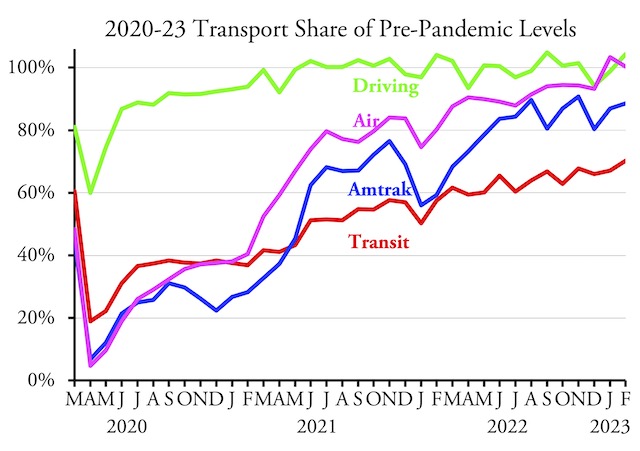Americans drove 224.1 billion miles in February 2023, which was 4.3 percent more than in the same month in 2019, according to data released by the Federal Highway Administration yesterday. This was the biggest increase in driving over pre-pandemic levels since the pandemic began.
For more information on transit, Amtrak, and air travel, see Monday’s post.
Driving increased, relative to 2019, on all kinds of roads in both urban and rural areas. Urban driving was 2.5 percent greater than in 2019; rural driving was 10.2 percent greater.
Driving increased the most in Delaware, where urban driving was 30 percent greater and rural driving an incredible 93 percent greater than in February 2019. Increases in most states were more modest, but Louisianans drove 46 percent more miles, Arkansans 28 percent more, Montanans 22 percent more, and Missourians 20 percent more than in 2019. Only a few states were still driving fewer miles than before the pandemic, including California (-6%), Connecticut (-10%), Illinois (-9%), Maine (-6%), Massachusetts (-2%), Michigan (-4%), Minnesota (-5%), Nevada (-1%), New Mexico (-15%), New York (-8%), North Dakota (-2%), Oregon (-.2%), Washington (-12%), and West Virginia (-6%).
One reason for the increase in driving is the increased number of people who work at home, as people who work at home seem to drive more miles per day than people who commute to work elsewhere. According to the New York Times, efforts to get people to return to offices simply aren’t working. While fewer people are working at home than at the peak of the pandemic, the “share of work days that are worked from home,” says another New York Times article, “is stabilizing at close to 30 percent,” which is several times greater than in 2019.
That amount of working at home means about 15 percent less driving to work but close to 50 percent less commuting by transit. Miles of driving are made up for by telecommuters doing errands, going for coffee, or doing other mid-day driving, while less transit commuting probably isn’t made up for by more use of transit for other purposes.









Caltrain
@Caltrain
·
Apr 6
Caltrain’s budget was covered by 75% fares pre-pandemic. Today it’s under 25%.
Caltrain lost 98% of ridership the month of the pandemic start. It has had the slowest recovery of all Bay Area transit agencies.